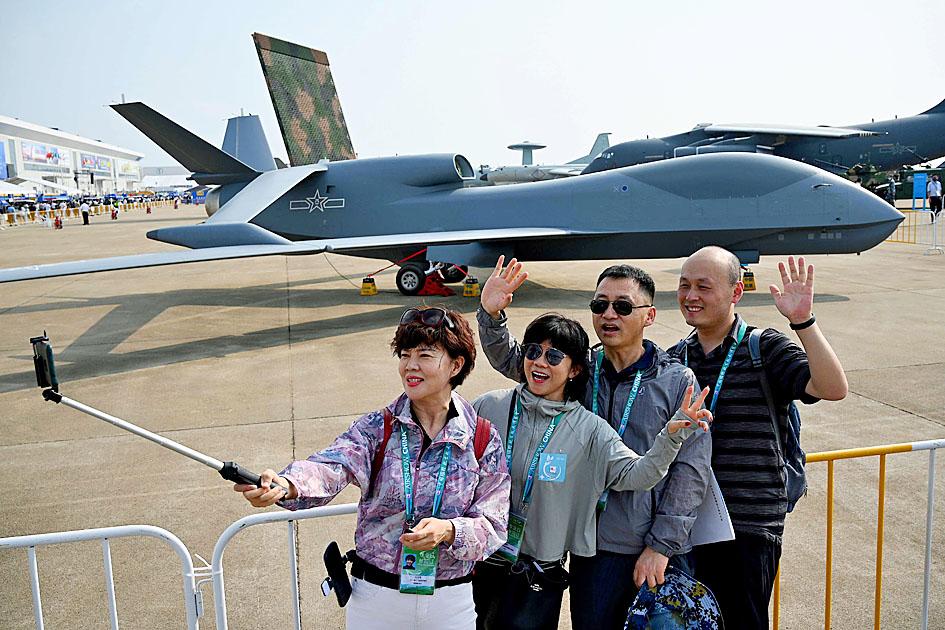China yesterday showed off its increasingly sophisticated air power, including surveillance drones, with an eye on disputed territories from Taiwan to the South China Sea and its rivalry with the US.
The nation’s biggest airshow, in the southern coastal city of Zhuhai, comes as Beijing pushes to meet a 2035 deadline to retool its military for modern warfare.
China still lags the US in terms of technology and investment in its war machine, but experts say it is narrowing the gap.

Photo: AFP
A US intelligence report this year flagged China’s growing influence as one of Washington’s biggest threats.
An air force aerobatic team left colorful vapor trails as it maneuvered in formation, while visitors inspected new jets, drones and attack helicopters on the tarmac.
The CH-6, a prototype drone with a wingspan of 20.5m, was among the domestic technology unveiled.
It is designed for surveillance and can also carry weapons for strike missions, open-source intelligence agency Janes reported.
The drone has a cruising altitude of 10,000m, “but it can go as high as 15,000m,” said Qin Yongming, general manager of drone maker Aerospace CH UAV Co.
“It can fly for longer periods [than previous models] ... it can carry out longer missions, with higher efficiency without any time limits,” Qin said.
Other debutants included the WZ-7 high-altitude drone for border reconnaissance and maritime patrol, as well as the J-16D fighter that has the ability to jam electronic equipment.
Both have already entered service with the air force, state media reported.
“They will play a major role in both the Taiwan Strait and the South China Sea,” military commentator Song Zhongping (宋忠平) said.
Under former US president Donald Trump, Washington authorized about US$18 billion of arms sales to Taiwan, including advanced missile platforms — sales that angered Beijing.
China is also “clearly positioning itself to be an alternative supplier” of advanced drones, with relative affordability, Janes analyst Kelvin Wong (黃加榮) said.
The US and European nations have been hesitant to supply such equipment outside a select group of partners, he said.
Chinese drones have already seen combat action in the Middle East and have been sold to customers in other regions as well.
The J-16D improves the combat capabilities of the People’s Liberation Army, said James Char, a Chinese military expert at Singapore’s Nanyang Technological University.
The jet has wingtip pods to disrupt enemy electronic equipment and has drawn comparisons with the US-made EA-18G Growler.
“It gives the Chinese military an advantage in terms of conducting aerial electronic warfare over targets that possess significant air defense capabilities,” Char said.
The Zhuhai airshow, usually held every two years, was postponed from last year due to the COVID-19 pandemic, and is being staged before a largely domestic audience due to quarantine and travel restrictions.

SECURITY: As China is ‘reshaping’ Hong Kong’s population, Taiwan must raise the eligibility threshold for applications from Hong Kongers, Chiu Chui-cheng said When Hong Kong and Macau citizens apply for residency in Taiwan, it would be under a new category that includes a “national security observation period,” Mainland Affairs Council (MAC) Minister Chiu Chui-cheng (邱垂正) said yesterday. President William Lai (賴清德) on March 13 announced 17 strategies to counter China’s aggression toward Taiwan, including incorporating national security considerations into the review process for residency applications from Hong Kong and Macau citizens. The situation in Hong Kong is constantly changing, Chiu said to media yesterday on the sidelines of the Taipei Technology Run hosted by the Taipei Neihu Technology Park Development Association. With

CARROT AND STICK: While unrelenting in its military threats, China attracted nearly 40,000 Taiwanese to over 400 business events last year Nearly 40,000 Taiwanese last year joined industry events in China, such as conferences and trade fairs, supported by the Chinese government, a study showed yesterday, as Beijing ramps up a charm offensive toward Taipei alongside military pressure. China has long taken a carrot-and-stick approach to Taiwan, threatening it with the prospect of military action while reaching out to those it believes are amenable to Beijing’s point of view. Taiwanese security officials are wary of what they see as Beijing’s influence campaigns to sway public opinion after Taipei and Beijing gradually resumed travel links halted by the COVID-19 pandemic, but the scale of

A US Marine Corps regiment equipped with Naval Strike Missiles (NSM) is set to participate in the upcoming Balikatan 25 exercise in the Luzon Strait, marking the system’s first-ever deployment in the Philippines. US and Philippine officials have separately confirmed that the Navy Marine Expeditionary Ship Interdiction System (NMESIS) — the mobile launch platform for the Naval Strike Missile — would take part in the joint exercise. The missiles are being deployed to “a strategic first island chain chokepoint” in the waters between Taiwan proper and the Philippines, US-based Naval News reported. “The Luzon Strait and Bashi Channel represent a critical access

Pope Francis is be laid to rest on Saturday after lying in state for three days in St Peter’s Basilica, where the faithful are expected to flock to pay their respects to history’s first Latin American pontiff. The cardinals met yesterday in the Vatican’s synod hall to chart the next steps before a conclave begins to choose Francis’ successor, as condolences poured in from around the world. According to current norms, the conclave must begin between May 5 and 10. The cardinals set the funeral for Saturday at 10am in St Peter’s Square, to be celebrated by the dean of the College